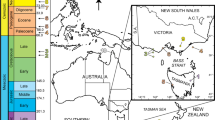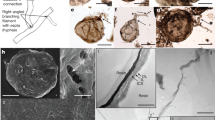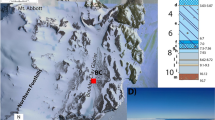Amber as old as the first dinosaurs captured the diversity of microbial life 220 million years ago.
Abstract
Amber provides an effective medium for conservation of soft-bodied microorganisms1,2,3,4,5,6, but finds older than 135 million years are very rare and have not so far contained any microbial inclusions. Here we describe 220-million-year-old droplets of amber containing bacteria, fungi, algae and protozoans that are assignable to extant genera. These inclusions provide insight into the evolution and palaeoecology of Lower Mesozoic microorganisms: it seems that the basal levels of food webs of terrestrial communities (biocoenoses) have undergone little or no morphological change from the Triassic to the Recent.
Similar content being viewed by others
Main
The largest known deposit of Triassic amber was discovered near the town of Cortina d'Ampezzo in the Italian Dolomites (southern Alps)7. Several thousand millimetre-sized drop-shaped pieces of amber (Fig. 1a) per square metre were preserved in a palaeosol (for details, see supplementary information).
a, Drop-shaped piece of amber with a broken tip. Scale bar, 500 µm. b, Alga similar to the extant desmid genus Cosmarium. The flattened cell consists of two almost symmetrical half-cells, each of which contains a large disc-shaped chloroplast (dark area). Scale bar, 10 µm. c, Ciliate of the genus Coleps. The barrel-shaped cell body shows rows of largely reniform perforations at its surface. Arrows indicate the typical posterior spines. Scale bar, 5 µm. d, Testate amoeba Centropyxis hirsuta. Scale bar, 10 µm. (For further details, see supplementary information.)
Bacteria were the most abundant microbes in these drops. Anamorphic fungi including some conidia-producing fungi that might be related to the extant genus Ramularia were present. Besides tiny chlorophytes and resting stages of several algae, the oldest known fossils of vegetative cells of conjugatophytes were also evident inside the droplets (Fig. 1b). These desmids are similar to the extant genus Cosmarium and were embedded at different stages of asexual reproduction. Ciliate protozoans are well preserved and, inter alia, a ciliate of the modern genus Coleps (family Colepidae) is identifiable (Fig. 1c).
Testate amoebae are represented by several species of the families Centropyxidae and Difflugiidae, and this is the earliest evidence of non-marine testaceans. Judging by its shape, size and the eccentric round pseudostome, the inclusion shown in Fig. 1d is morphologically identical to extant representatives of Centropyxis hirsuta Deflandre and therefore represents the earliest occurrence of a species of protozoan that survives today. As in extant individuals that live in mosses, soil or on bark, no spines are evident on the fossil shell8.
Representatives of all trophic levels of the microbiocoenosis were preserved in these samples of Triassic amber: bacteria, and phototrophic algae as producers, protozoans as consumers, and fungi as decomposers. Bacteria are the food source of testate amoebae and some ciliates; microalgae may be grazed upon by ciliates as well. Extant species of the ciliate genus Coleps also prey on other ciliates, flagellates, and on small metazoans. Freshwater rhizopods occur in high densities in extant aquatic and terrestrial habitats and participate to a high degree in secondary production. Our discovery of associations of several species in just one piece of amber indicates that these representatives of different testacean families had settled in such habitats, outside large bodies of water, by the time of the Triassic.
Humid coastal forests of the archaic conifer family Cheirolepidiaceae at the northern rim of the Tethys Sea are likely to be the amber source9. The drop-shaped pieces of amber solidified on their resin-bearing plants and later fell onto the soil. The microbes must therefore have been living on plants; no accompanying soil organisms were enclosed. The occurrence of conjugatophytes and aquatic ciliates indicates that they probably lived in limnetic−terrestrial habitats, such as wet bark or small water-filled treeholes (phytotelmata).
Microorganisms of limnetic and terrestrial biocoenoses are important in modern ecosystems, but until now their fossil record has been poor. Our findings show that different genera, and even species, of microbial taxa have been able to survive geological epochs. Higher levels in food webs, on the other hand, have been shaped by environmental changes, such as those that caused the mass extinction at the Cretaceous–Palaeogene boundary. Unchanged since the Lower Mesozoic, protozoans survived the entire era of the dinosaurs, as well as the diversification of angiosperms, birds and mammals.
References
Waggoner, B. M. Lethaia 27, 77–84 (1994).
Schönborn, W., Dörfelt, H., Foissner, W., Krienitz, L. & Schäfer, U. J. Eukaryot. Microbiol. 46, 571–584 (1999).
Dörfelt, H. & Schäfer, U. Hoppea 61, 785–793 (2000).
Rikkinen, J. Jr & Poinar, G. O. Mycol. Res. 104, 7–15 (2000).
Schmidt, A. R., Schönborn, W. & Schäfer, U. Palaeontology 47, 185–197 (2004).
Dörfelt, H. & Schmidt, A. R. Palaeontology 49, 1013–1017 (2006).
Roghi, G., Ragazzi, E. & Gianolla, P. Palaios 21, 143–154 (2006).
Schönborn, W. Limnologica 1, 111–182 (1962).
Roghi, G. Rev. Palaeobot. Palynol. 132, 1–35 (2004).
Author information
Authors and Affiliations
Corresponding author
Ethics declarations
Competing interests
The authors declare no competing financial interests.
Supplementary information
Supplementary information
description (PDF 579 kb)
Rights and permissions
About this article
Cite this article
Schmidt, A., Ragazzi, E., Coppellotti, O. et al. A microworld in Triassic amber. Nature 444, 835 (2006). https://doi.org/10.1038/444835a
Received:
Accepted:
Published:
Issue Date:
DOI: https://doi.org/10.1038/444835a
This article is cited by
-
A Myanmar amber cockroach with protruding feces contains pollen and a rich microcenosis
The Science of Nature (2020)
-
Fungi trapped in amber—a fossil legacy frozen in time
Mycological Progress (2019)
-
Resin exudation and resinicolous communities on Araucaria humboldtensis in New Caledonia
Arthropod-Plant Interactions (2017)
-
Sub/fossil resin research in the 21st Century: trends and perspectives
PalZ (2016)
Comments
By submitting a comment you agree to abide by our Terms and Community Guidelines. If you find something abusive or that does not comply with our terms or guidelines please flag it as inappropriate.




